Beth Kanell's Blog, page 26
March 11, 2012
Sisters in Crime, Vermont -- March 11, 2012
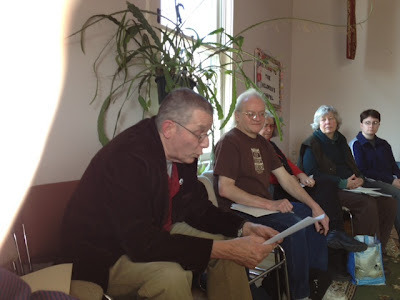 Jim DeFilippi read from his "work in progress," a new "Speedo" crime novel, this afternoon in Montpelier, VT, at the first (annual) gathering of Vermont mystery writers via Sisters in Crime, New England. Great reading, Jim! Seven other authors also read new work -- fabulous gathering! 28 people on hand. Major thanks to Nancy Means Wright for taking the initiative to pull this together.
Jim DeFilippi read from his "work in progress," a new "Speedo" crime novel, this afternoon in Montpelier, VT, at the first (annual) gathering of Vermont mystery writers via Sisters in Crime, New England. Great reading, Jim! Seven other authors also read new work -- fabulous gathering! 28 people on hand. Major thanks to Nancy Means Wright for taking the initiative to pull this together.In fact, as you can see here, Nancy (left) and I had a great time -- Nancy read from her new Mary Wollstonecraft novel, and I aired the second chapter of the adventures of Montpelier, Vermont's, own Nancy Drew: Felicity "Lucky" Franklin.
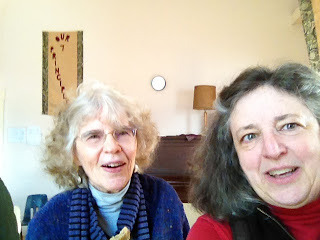
Published on March 11, 2012 18:27
March 8, 2012
Start of a New Mystery: "All That Glitters," Began in Public Today!
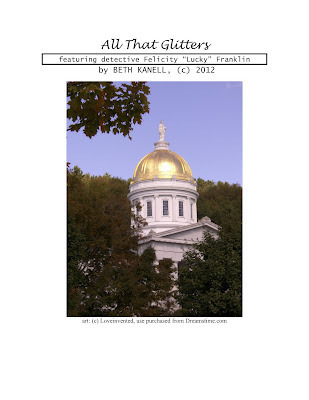 I feel like a first grader. No, honestly, I do: trying to learn dozens of new things on the first day.
I feel like a first grader. No, honestly, I do: trying to learn dozens of new things on the first day.The reason: I just started presenting a brand new novel of mine on a social writing/reading site called Wattpad. In the past 24 hours, I've created an account, read some stories on the site written by other people (and applauded them!), created a draft cover for the book (it will get better when I can get a pro to help on it), and uploaded the first chapter of the novel.
If you're willing to sample the adventure, take a look at the chapter, right here: http://www.wattpad.com/3668250-all-that-glitters-chapter-1/intro
And, oh yes, I've written chapter 2, to upload in a few days (running out of breath by now!).
Here's a short description of All That Glitters:
Nancy Drew for today? If you loved the old series, or have longed to see a "girl detective" that makes sense today -- at college, smart, driven to solve mysteries, tech-savvy, and with friends who'd (almost) die for her -- you'll enjoy the adventures of Felicity "Lucky" Franklin.
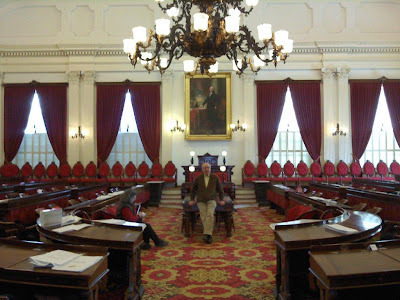 Plus, in the true spirit of Nancy Drew, I'm doing my research with a "chum" -- yesterday my friend Pam and I toured the State House in Montpelier, courtesy of the very knowledgeable and courteous David Schütz, curator of state buildings. I took notes like crazy, and Pam took photos. If you peek here, you can see Mr. Schütz sitting in the center of the House Chamber at the magnificent Capitol building. And that person madly scribbling down the details? Yours truly.
Plus, in the true spirit of Nancy Drew, I'm doing my research with a "chum" -- yesterday my friend Pam and I toured the State House in Montpelier, courtesy of the very knowledgeable and courteous David Schütz, curator of state buildings. I took notes like crazy, and Pam took photos. If you peek here, you can see Mr. Schütz sitting in the center of the House Chamber at the magnificent Capitol building. And that person madly scribbling down the details? Yours truly.
Published on March 08, 2012 13:54
March 4, 2012
Time Travel in Fiction: THE HUNGER GAMES and LORD OF THE RINGS
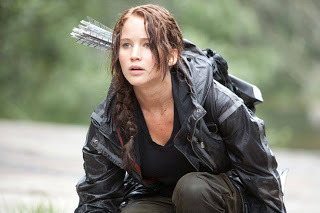 Every author has a different way to "get into the mood" for writing. Today I pulled on my new "Team Katniss" sweatshirt and the words flowed well, until time-to-make-breakfast interrupted.
Every author has a different way to "get into the mood" for writing. Today I pulled on my new "Team Katniss" sweatshirt and the words flowed well, until time-to-make-breakfast interrupted.Katniss, in case you haven't followed recent YA adventures or you don't have a TV where the movie trailers are airing (for the March 23 film release), is the protagonist of The Hunger Games and its fierce sequels, Catching Fire and Mockingjay. She lives in a post-disaster America called Panem, and, as in Eliot Pattison's detection series also set in the future (first book is Ashes of the Earth), her society has been knocked back to primitive in many ways. Katniss's most obvious skill is hunting with a bow and arrows; her more important one is sorting out right from wrong, I think.
I'm not always comfortable with the way books blend the skills of the past with the robotics, computer life, and communications of the future. But I had no trouble "suspending disbelief" for The Hunger Games. I've just enjoyed my third time reading the trilogy.
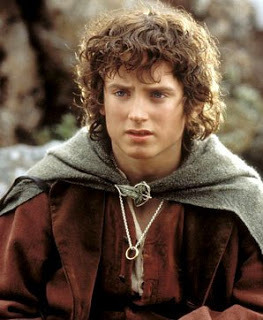 It's also a good counterbalance to the trilogy that haunted my teens, The Lord of the Rings. When I re-read this threesome recently, it hit me for the first time that there were no strong personalities among the women there -- I didn't really notice before, because I've always identified fully with Frodo in Tolkien's trilogy, ignoring his gender and instead connecting with his sense of being way too deep in something he doesn't understand, yet determined to somehow go forward and meet his own commitments to justice. (Well, let's emphasize that I try.)
It's also a good counterbalance to the trilogy that haunted my teens, The Lord of the Rings. When I re-read this threesome recently, it hit me for the first time that there were no strong personalities among the women there -- I didn't really notice before, because I've always identified fully with Frodo in Tolkien's trilogy, ignoring his gender and instead connecting with his sense of being way too deep in something he doesn't understand, yet determined to somehow go forward and meet his own commitments to justice. (Well, let's emphasize that I try.)So it's a relief really to be able to identify directly with Katniss and at the same time with her gender and her hesitations around whether "love" is going to work for her, and how to define it. The most important part of The Hunger Games is fighting for survival and then for freedom. But a story's not going to be much good unless the people in it matter to the reader, and Katniss matters to me.
Let me wrap up this post with on off-topic but heartfelt shout of thanks to Flamingnet Teen Book Reviews Blog, where The Secret Room (set firmly in "today") made an appearance on Friday. Many thanks for the perceptive analysis of the book! And yes, there is a sequel on the way, that picks up where Shawna left off at the end of The Secret Room. More about that, another time.
Published on March 04, 2012 09:47
February 8, 2012
Threats Against Immigrants in Vermont: The Ku Klux Klan
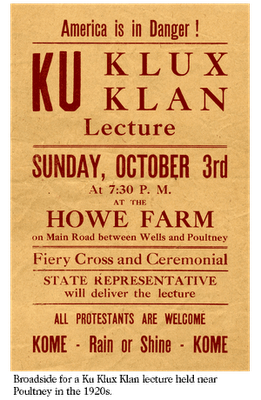 As we head toward Vermont's Town Meeting Day on the first Tuesday of March, we can expect to hear mention of who is "from here" and who is "from away." There are real differences involved: People who live in Vermont for a long time develop ways to connect and cope with seasons, distances, geography. Families who have generations of experience to rely on develop some of the best skills -- as well as treasured traditions. As I listen to my house creak and ache during subzero nights, I remember especially Mrs. Lucille Poutre of Irasburg, who taught me the importance of "banking" the house foundation for winter.
As we head toward Vermont's Town Meeting Day on the first Tuesday of March, we can expect to hear mention of who is "from here" and who is "from away." There are real differences involved: People who live in Vermont for a long time develop ways to connect and cope with seasons, distances, geography. Families who have generations of experience to rely on develop some of the best skills -- as well as treasured traditions. As I listen to my house creak and ache during subzero nights, I remember especially Mrs. Lucille Poutre of Irasburg, who taught me the importance of "banking" the house foundation for winter.At the same time, those who arrive in Vermont "from away" bring perspectives and experiences that are often helpful in finding a way to survive other challenges: economic, technological, and the growing pains that associate with more obvious diversity in the state. If you grow up in a more diverse area, you can bring those skills with you as you arrive in the Green Mountains. They matter especially at Town Meeting, when our commitment to working democracy means finding ways to hear each other.
But it's an oversimplification to say that Vermont is "becoming diverse." The state has always had people from varied backgrounds, and the human tendency to divide them into "us" and "them" has dogged us all along. The Darkness Under the Water, my young adult novel of 1930 that walks with 16-year-old Molly Ballou through some of the challenges of that time, portrays the casual bigotry that was present, and some frightening -- and sometimes heroic -- results.
In the upcoming issue of Vermont's Northland Journal , editor/writer Scott Wheeler presents an interview of a 97-year-old resident of Newport, Vermont, who mentions the Ku Klux Klan burning "fiery crosses of hate" on a hill above the town. To many, the "KKK" is associated with terrorizing African Americans in the Deep South, especially in the early 1900s before Civil Right legislation took hold. It can be a shock to realize that the KKK was also present in New England, including in Vermont.
The Vermont Historical Society describes some KKK activity within its Freedom and Unity exhibit, for which much of the material is still available online; the poster shown above is from that exhibit.
State-sponsored bigotry disguised with the "scientific process" became the Vermont Eugenics Survey, documented by the University of Vermont, again with material available online (read the letters exchanged on the Eugenics Commission).
For a look at a KKK threat to Catholics during the 1920s, check this page from St. Augustine Church in Montpelier.
And I hope the webpage on the Vermont Eugenics Survey at "Abenaki Nation" will interest many readers in listening to the voices of Vermont's Native Americans, whose persecution during the 1920s and 1930s led directly to their invisibility in the state in the 1940s, 1950s, 1960s ... the enabling legislation for sterilization of the "unfit" was not repealed in Vermont until 1971.
It may indeed be human to say "them" and "us" -- but it's dangerous, can be cruel, and, like the burning crosses of the Ku Klux Klan, leaves us a legacy of pain and discrimination that takes generations of activity to heal, restoring justice.
Published on February 08, 2012 05:32
February 4, 2012
Strep Throat, Telephones, and the Eugenics Movement
 photo by Stephanie KrishnanI've been learning about Alexander Graham Bell today. Until recently, all I really knew about him was that he "invented the telephone," and that he'd taken part in the eugenics movement that lies behind the story in my book The Darkness Under the Water.
photo by Stephanie KrishnanI've been learning about Alexander Graham Bell today. Until recently, all I really knew about him was that he "invented the telephone," and that he'd taken part in the eugenics movement that lies behind the story in my book The Darkness Under the Water.When I worked on the background history for the book, I read the massive nonfiction work War Against the Weak: Eugenics and America's Campaign to Create a Master Race, by Edwin Black. More than 500 pages long, including 50 pages of footnotes, this book contains the results of decades of research by Black and his team. I especially paid attention to the sections in the book that detailed the Vermont Eugenics Project (given at more length in Nancy Gallagher's book Breeding Better Vermonters). And although I noticed Bell's participation nationally, it didn't interest me much at that time.
But yesterday I finished up an article for one of my other blogs (http://kingdombks.blogspot.com) in which I mentioned a historical mystery by Victoria Thompson called Murder in Chinatown. My husband Dave reminded me that he had another Victoria Thompson mystery for me to read: Murder on Lexington Avenue. In this one, Detective Inspector Frank Malloy and trained midwife Sarah Brandt, in turn-of-the-century (that is, around 1900) New York City, discover the havoc created in a family where Alexander Graham Bell's ideas about deafness affect how the father makes decisions for his deaf teenage daughter.
And those ideas, in Thompson's story, are expressed as part of the eugenics ideas -- the ideas about "cleaning up" or "improving" the genetic basis of humans through choices in who has babies with whom. Oh, it's easy to shudder now -- we can see the terrible flaws in those ideas, especially when we know what Adolf Hitler's ideas on the subject did in the world -- but many well-meaning people missed the danger and thought they were making "right decisions" by stepping in and controlling, in one way or another, who would be able to have children. And in Thompson's book, Bell's ideas are in favor of teaching the deaf to lip-read and speak (even if their speech sounds odd), in order to be part of society -- and Bell felt that deaf people should not marry each other, because they could then produce more deaf children and increase the pain in the world.
Bell's passion for enabling the deaf to be part of the social world around them came partly from his love for his own deaf mother, and partly from his marrying a woman who was deaf -- and who had become deaf at age five, from being ill with scarlet fever (caused by the same organism that causes strep throat).
One of his most famous students was Helen Keller, now well known for her success in moving beyond her own blindness and deafness to become a leader among Americans and worldwide. And Bell's efforts to assist hearing led to the telephone's invention. (Video here!)
But Bell turned out to be mistaken about deaf parents inevitably having deaf children, and as Edwin Black confirms, Bell also did not like the way the eugenics movement began to concentrate on "eliminating" the "negatives" in people -- he wanted instead to see a focus on encouraging positives.
At any rate, the eugenics movement went on without Bell's support, and provided the reasoning for terrible events in America, as well as in Germany. Just last month, the state of North Carolina received a report from its governor's Eugenics Task Force, recommending that the state give $50,000 per victim to people who could show that North Carolina's government had forcibly done surgery on them or their families between 1929 and 1974, under the "eugenics" ideas ("stop the wrong people from having children").
I am so glad that this beginning of justice, and of admitting that government makes terrible mistakes sometimes, has started for North Carolina.
North Carolina wasn't the only state where this happened, though. In Vermont, where the very real effects of a state eugenics law are part of the historical fiction in The Darkness Under the Water, apologies for the state's treatment of its Native Americans have only just begun. And there were 29 more states where laws focused on "sterilizing" -- forcing surgery that would prevent people from having children -- during those years.
In North Carolina about 7,600 people were sterilized; in Virginia about 8,000; and in California, about 20,000, with a national total of some 60,000 people.
What can we do about the evidence of so much injustice? I think we each have a responsibility to try to make things right.
Interested in learning more about how American views of deafness and actions among both the deaf and hearing communities have changed over the years (and Alexander Graham Bell's role, too)? Consider watching the PBS film Through Deaf Eyes. The DVD is easy to purchase, and there's a lot of free and interesting information on the film's website.
Published on February 04, 2012 14:04
January 24, 2012
Election Fever Can Mean Collecting "History" and Testing Data
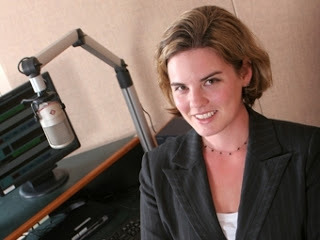 Vermont Edition radio host Jane LindholmFrom now until November, Americans will hear a lot about politics and government. It's tempting to support candidates who believe the same things we do, or who seem to face life the way we do.
Vermont Edition radio host Jane LindholmFrom now until November, Americans will hear a lot about politics and government. It's tempting to support candidates who believe the same things we do, or who seem to face life the way we do.But there's another way to see political speeches: In what they say and do, candidates to lead our country reveal what they believe America's history is, and what should be done about it, in order to shape the future for all Americans. That means, if we want a well-led country, we need to be history evaluators ourselves, in order to notice how good -- or not so good -- each candidate is in sorting out what really happened and what might happen in the years in front of us.
Shawna and Thea begin to sort out historical "facts" in this way in The Secret Room. Their eventual conclusions about the "real" Underground Railroad events in their village of North Upton are very different from where their opinions started. A fun way to evaluate their work might include listing their opinions from when they've first discovered the secret room, the kinds of research they do, and their opinions by the end of the book.
Looking for a real-life application of the same skills? Try listening to the speakers on this Vermont Public Radio broadcast from November 2011: host Jane Lindholm (an anthropologist as well as journalist), history professor Ray Zirblis, and me, your author of The Secret Room. Jot down what opinions are expressed by each speaker, and the evidence each one offers to back up those opinions. Then work slowly through the listener comments and questions posted on the radio station website, in response to the show. What opinions can you determine among the listeners? How are they responding to what they've heard?
Let me know what you find. And if you are trying this in a classroom or group, at any age, I'd love to know how it works out and where it leads you next.
[PS - If you're teaching with The Secret Room -- or any other YA historical fiction -- you might want to joint the teacher collaboration at http://www.facebook.com/groups/198457003547529. You're invited!]
Published on January 24, 2012 13:18
January 18, 2012
And the Mountain Is Connected to the Valley ...
 Pygmy shrew.Yesterday the odd markings of a tiny shrew crisscrossed the backyard. The smallest of mammals, a shrew looks like a mouse that never had a neck, with an added layer of fur. In snowy terrain, shrews travel underneath the snow, along the frozen ground. So how do you see their tracks? It's wild -- you see instead the lines of collapses at the snow surface, where the snow sinks down into the tiny tunnels beneath. Love it.
Pygmy shrew.Yesterday the odd markings of a tiny shrew crisscrossed the backyard. The smallest of mammals, a shrew looks like a mouse that never had a neck, with an added layer of fur. In snowy terrain, shrews travel underneath the snow, along the frozen ground. So how do you see their tracks? It's wild -- you see instead the lines of collapses at the snow surface, where the snow sinks down into the tiny tunnels beneath. Love it.Also in the backyard is a set of deer tracks leading directly to the wall of the house and back. Turns out the deer spotted the green grass revealed under the outside vent of the clothes dryer. I bet that was a tasty snack.
 Although my heart and books are always in Vermont, this snowy, windy ridgeline (this morning's wind is literally roaring) is also connected to the roads that go "elsewhere," including the roads of the Internet. Today they connect to Little Willow, whose website is a mountain-size resource room for readers. I especially like her list of books that deal with "tough topics for teens." And today I'm honored to be her guest for an interview about writing and about secret rooms. Thank you, Little Willow. It's wonderful to "be here."
Although my heart and books are always in Vermont, this snowy, windy ridgeline (this morning's wind is literally roaring) is also connected to the roads that go "elsewhere," including the roads of the Internet. Today they connect to Little Willow, whose website is a mountain-size resource room for readers. I especially like her list of books that deal with "tough topics for teens." And today I'm honored to be her guest for an interview about writing and about secret rooms. Thank you, Little Willow. It's wonderful to "be here."
Published on January 18, 2012 06:07
January 12, 2012
The Brighter the Light, the Darker the Shadow
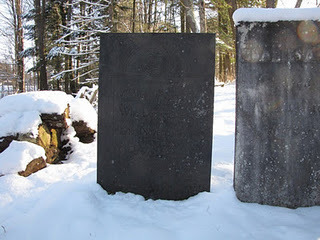 This photo is from a tiny cemetery just up the road from where I live; the stones in it mark deaths that took place about two hundred years ago, but -- they also mark lives. They stand for people who chose to farm and raise children on a high ridge of land where they could look west toward an amazing landscape of rolling mountains. And at that time, most of them probably had no idea what lay beyond those mountains. One of the markers here (the left-hand one; click on it to make it larger) is for Mrs. Submit Adams -- whose heritage, according to local writer Alan Boye, probably included Abenaki (Native American) family members. She may have been the earliest part-European to live on this ridgeline.
This photo is from a tiny cemetery just up the road from where I live; the stones in it mark deaths that took place about two hundred years ago, but -- they also mark lives. They stand for people who chose to farm and raise children on a high ridge of land where they could look west toward an amazing landscape of rolling mountains. And at that time, most of them probably had no idea what lay beyond those mountains. One of the markers here (the left-hand one; click on it to make it larger) is for Mrs. Submit Adams -- whose heritage, according to local writer Alan Boye, probably included Abenaki (Native American) family members. She may have been the earliest part-European to live on this ridgeline.I think that the more we learn about the people who've gone ahead of us, the more courage we can summon. We see how they lived with the darkness of winter nights, and the darkness of their souls sometimes. And for many of them, we see how they pulled themselves together. They witnessed wide skies of brilliant stars, or big-bellied glowing full moons; they woke again in the morning to the winter calls of chickadees (tiny birds that refuse to leave here in winter), the sparkle of sunlight on icicles, the bright ring of harness bells on horses. They left us their names, and sometimes their stories.
When a good novel follows a character's path through darkness, it shows where the light is also rising. It calls us to take the next right choice, take another step forward, sing something out loud for the friends following us through the woods. It was Carl Jung who said, "The brighter the light, the darker the shadow." But for the stories I want to research and tell, the saying may sometimes go the opposite way: "The darker the shadow, the brighter the light."
Published on January 12, 2012 12:32
December 26, 2011
History Mysteries for Delray Beach, Florida
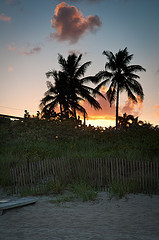 courtesy of Jeremy.WilburnI'm warming up to a revision of one manuscript and three other novels I plan to write -- two of them with first chapters already written.
courtesy of Jeremy.WilburnI'm warming up to a revision of one manuscript and three other novels I plan to write -- two of them with first chapters already written.Meanwhile, though, I recently offered to find "history mystery" possibilities for a classroom teacher in Delray Beach, Florida (if you're a teacher and would like to know more about history mysteries, please do check our teacher Facebook site -- ask to join and I'll "click" you into it: http://www.facebook.com/groups/198457003547529). And here's some of what I came up with:
History mysteries for Delray Beach -- Wow, I am so excited about this town's history! There could be at least a dozen fascinating plots woven from what I've seen already. (1) For instance, until 1845, the area's residents were Africans, Seminole Native Americans, and Black Seminoles -- can you imagine a journey into history by looking for evidence of each group? What were the similarities, differences, conflicts? If there are no records of that time, what does that mean in terms of how we value our history? (2) There are military maps of the peninsula of Florida dating from the 1850s and the Seminole Wars. There's a haulover (a portage location for boats), "Orange Grover Haulover." I would love to learn more about the Seminole Wars and set a mystery at this haulover. Who could leave messages there? What would they say? (3) A haven for the shipwrecked called the Orange Grove House of Refuge #3 was built in 1876 by the U.S. Lifesaving Service. The first refuge-keeper (like a lighthouse keeper, for you Yankees reading along) was Hannibal D. Pierce. If a story were called "Meeting Hannibal," what would happen to the young person narrating the story? There must have been pirates and navy heroes and clever craftsmen among the people living at the refuge! (4) When Henry Flagler was building railroads to connect all of Florida (1885), he bought a lot of land in the Delray Beach area. Many workers on the railroad were African Americans. Imagine their experience of the Civil War and the hopes and dreams they brought to the area when they came to work on the railroad. I am now picturing eighth-grade-age kids who make choices based on their parents' tales of war and railroad -- what arrives hidden among the railroad cars? Who slips in and out of town, bringing messages? The story is growing! (5) The Intercoastal Waterway dates to 1890 in Delray Beach -- can you trace how it's been used for recreation? For commerce? For smuggling? (6) The first school in town (the town was Linton then) in 1894 was established by African-Americans and was a "pioneer school" probably built with palm fronds. I "hear" a mystery that involves someone who wants to be in the school but can't, and who has a pet, and isn't afraid of snakes or palm bugs ... (7) Why did Adolf Hofman come to town in 1895 and what kind of farming did he set up in Delray Beach? I bet his family had a hard time during World War II -- can you explain why? There could be a mystery of messages, heroism, and danger. (8) Who was Mary Cohen and how did she become a midwife? In 1896, I would have wanted to know her! Does her last name mean she had some connections to Jewish heritage? What resources did she have? Picture a mystery about two babies born on the same day, and how she copes with it, and how the families get tangled and maybe give back something in terms of helping save "Auntie" Cohen from danger! (9) I want to know more about the Yamamoto agriculture colony, with all Japanese men at first (brought by Henry Flagler), then wives, children, a school ... what happened to the people from this 1904 group, when World War II arrived? I am picturing a mystery that involves a friendship among three kids of various ancestry, trying to figure out how to make things better for the ones who are Japanese. See why I think this could be the perfect place for history mysteries?? In case you need more info, there's a brand new book of photos of Delray Beach history, too, and here's an article about a time capsule -- don't you get the urge to make a time capsule with your class? http://www.palmbeachpost.com/community-post/delray-beach-historical-society-archivist-finds-long-forgotten-1973156.html
Published on December 26, 2011 11:28
December 9, 2011
The Underground Railroad in Vermont: The Real One
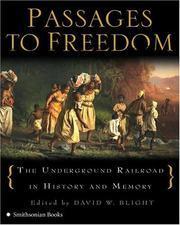 Many thanks to the Barnet Junior Historical Society, with mentor Sherry Tolle, who invited me to join the group of grade 2 to grade 6 students at the Barnet (VT) School library today. From the girls up front to the boys at the back table, everyone had opinions and information to offer about what the Underground Railroad was, and whether there could be hiding places in local houses that had a connection with the movement to make sure fugitives from slavery were able to reach freedom, safely.
Many thanks to the Barnet Junior Historical Society, with mentor Sherry Tolle, who invited me to join the group of grade 2 to grade 6 students at the Barnet (VT) School library today. From the girls up front to the boys at the back table, everyone had opinions and information to offer about what the Underground Railroad was, and whether there could be hiding places in local houses that had a connection with the movement to make sure fugitives from slavery were able to reach freedom, safely.Mr. David Warden, a leader in the Barnet Historical Society, was also on hand and gave some details about older houses in town, especially the Goodwillie House, where a double wall in the cellar has sometimes been assumed to be a hiding place from the Underground Railroad movement.
We talked about what the UGRR really was (no train tracks; not underneath the ground), why it was so important, and why the hiding places in Vermont -- especially in this area, the Northeast Kingdom -- probably weren't for hiding people. Probably the most important part of the reasons was the absence of slave hunters in Vermont. Passages to Freedom: The Underground Railroad in History and Memory, edited by David W. Blight, says this:
Probably the most important factor in making Vermont a safe haven for runaways was simply its geography. The sheer physical distance from the slave South to Vermont was just too great to make capture economically feasible. Historians John Hope Franklin and Loren Schewininger have shown that the cost to the slave catcher could exceed the value of the fugitive if the search extended too far or too long. (p. 256)That led to a discussion of how "stories" about slave hunters started in Vermont anyway, and why people want to believe in an Underground Railroad version that's closer to being a "story" than to being "history." One of the students compared this to the long-held "official" view that the earth was flat, even though sailors all knew it was round, because of what they saw every day at sea. Good comparison!
For teachers, librarians, and historical groups looking for a good handout for elementary-grade students, check this offering from the National Park Service, free for downloading and printing: http://www.nps.gov/subjects/ugrr/education/index.htm -- and click on "Junior Ranger Booklet."
Thanks again, Mrs. Tolle, for mentoring such a lively club and inviting me to meet with your students!
Published on December 09, 2011 17:09



